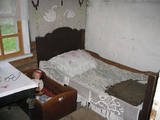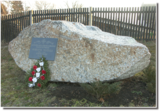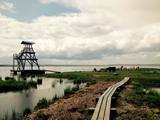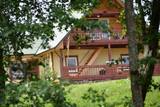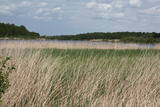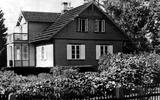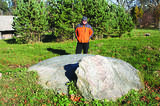| Nr | Name | Beschreibung |
|---|---|---|
|
Der älteste Teil der jetzigen Wohnriege ist die Riegenstube mit dem Erdfussboden aus 19.Jh. Das Wohnzimmer mit Kammern wurde in der II. Hälfte des XIX. Jahrhunderts gebaut. |
||
|
Der Gedenkstein an Augusts Muižulis, der der Kavalier des Ordens von Lāčplēsis (Bärentöter – lettischer Sagenheld) war, befindet sich in Lapmežciems am Kilometerpfosten Nr. 9 der Straße Jūrmala – Talsi (P 128). Augusts Muižulis (1893 – 1941) war der Oberleutnant des 4. Infanterieregiments von Valmiera. Das Haus Tuteņi, das sich nebenan befindet, war sein Familienhaus. |
||
|
Vilsandi nacionālā parka „sirds” un divpadsmitā lielākā Igaunijas sala (garums - 6 km, platums – 2 km). Tā ir ļoti „jauna” sala, kas sākusi veidoties pirms ~ 2000 gadiem zemes garozas celšanās rezultātā, savienojoties divām salām, kas noticis pirms ~ 350 gadiem. Cilvēki salu sāka apdzīvot 18. gs. un to galvenā nodarbe bija zvejniecība, kuģu būve, nelielā apjomā – lauksaimniecība. Līdz 2. pasaules karam te bija ap 200 iedzīvotāju, kuri vēlāk salu bija spiesti pamest PRSR pierobežas režīma zonas dēļ. Nozīmīgu Vilsandi daļu aizņem mežs un kadiķu lauki. To visā garumā šķērso grantēts - zemes ceļš ar atzariem uz jūras krastu. Salu ar kājām var izstaigāt vairāku stundu laikā, iepazīstot vietējo apbūvi (daļa arī mūsdienās celtas ēkas) un Tolli sētu, kur pēc nostāstiem dzīvojis nīderlandiešu jūras braucējs Johans Dolls, kā arī vējdzirnavas. Noteikti ir jāaiziet līdz salas rietumu krastam, kur atrodas Vilsandi bāka un bākas uzrauga saimniecības ēkas. No šejienes ir labi redzamas Vaikas salas. Šodien uz salas pastāvīgi (visa gada garumā) dzīvo tikai trīs cilvēki. |
||
|
Atrodas vēsturiskā rātslaukuma dienvidu malā. Jaunā rātsnama celtniecība (itāļu renesanses stilā, arhitekts O. Dīce) tika pabeigta 1860. gadā. Iespaidīgo celtni, kas nulle kā atjaunota, ir vērts apskatīt gan no āra, gan iekšpuses. Ir restaurēts rātsnama pulkstenis, ārējā fasāde, iekšējie interjeri un Lielā zāle. |
||
|
Bis zum 13. Jh. gehörte der Kreis von Smiltene zu dem von den Letgallen bewohnten Land Tālava. Nach der Invasion der Kreuzritter hat den Kreis der Erzbischof von Riga bekommen und am steilen Ufer des Flusses Abuls hat er im Jahr 1370 eine Burg gebaut. Die nachfolgenden Kriege und Seuchen haben weder die Bebauung der Ortschaft, noch die Einwohner geschützt. Die heutigen Konturen der Stadt begannen sich am Ende des 19. Jhs. mit den aktiven Tätigkeiten des Barons von Lieven – des Landgutinhabers von Smiltene – zu bilden. Bis zum Ersten Weltkrieg arbeitete in Smiltene eine Holzverarbeitungsfabrik, ein Wasserkraftwerk (1901, das erste in den Baltischen Ländern) und andere Unternehmen. Als sich im Jahr 1944 die deutschen Streitkräfte zurückgezogen haben, wurde in einem Brand der größte Teil der historischen Bebauung der Stadt zerstört. |
||
|
Pirts noma, izmitināšana, ēdināšana, banketu zāles noma, internets, makšķerēšana, volejbola laukums. |
||
|
Meklējams Matsalu līča dienvidu krastā pie Kēmu ostas (Keemu sadam). Blakus sešus metrus augstajam metāla – koka tornim uzcelts neliels apmeklētāju centrs. Tāpat kā no Haeskas torņa, arī no šī paveras viena no izcilākajām Matsalu līča un tā piekrastes ainavām. Laba putnu vērošanas vieta migrāciju laikā. |
||
|
Engures apkaimē aug 22 no Latvijā sastopamajām 32 orhideju dzimtas sugām .Lai dabas parka apmeklētājiem dotu iespēju aplūkot šīs interesantās augu sugas, ierīkota Orhideju taka. Kopējais takas garums ir 3.5 km, tā sākas netālu no Engures Ornitoloģisko pētījumu centra, līkumo caur kalcifilajiem purviem un mežam putnu novērošanas torņa virzienā, un aizvijas tālāk gar atjaunoto ezera piekrastes pļavu, kurā mīt govis un zirgi. Takas sākumā novietotajā informācijas zīmē attēlotas ne tikai apkārtnē sastopamās orhidejas. Tur iespējams gūt daudzpusīgu informāciju arī par citām interesantām Engures ezera dabas parka augu sugām.
|
||
|
Tūristu nometne, smailīšu noma laivošanai pa Šventosios (Svēto) upi un tās pietekām Vyžuonos, Jaros upēm. Piedāvājumā 4 atsevišķas atpūtas vietas ar teltīm, kurās pieejamas dārza mēbeles, vieta grillēšanai, iesmi, pirts upes krastā, āra tualete, mazgāšanās telpa, bērnu rotaļu, volejbola un futbola laukumi. Lielajā dārzā iespējams uzņemt līdz 50 cilvēkiem. Vieta svinībām, festivālu rīkošanai, sanāksmēm un semināriem. Vienā no mājām ir pirts, kā arī divas Krievu prirtis un kubls upes krastā. Piedāvājumā ēdienu pēc iepriekšēja pieprasījuma. |
||
|
Im historischen Eiskeller des Landguts Alatskivi werden Wein, Kräutertee, essbare Souvenirs, Gewürzessig und Konfitüren von der Ernte aus den umgebenden Wäldern und Feldern gemacht. Im gemütlichen Laden kann man Wein, Tee sowie andere örtliche essbare Souvenirs probieren und kaufen. Ist die Gruppe groß oder möchten Sie uns außerhalb der Arbeitszeiten besuchen, bitten wir Sie, Ihre Ankunft im Voraus anzumelden. |
||
|
Die Hauptstadt Litauens. Eine der größten Altstädte Osteuropas, ist in die UNESCO Liste des Weltkulturerbes aufgenommen worden. In der Altstadt sind verschiedene architektonische Stile dargestellt: Klassizismus, Barock, Gotik, Renaissance u.a. |
||
|
Das Urstromtal Abava zwischen Kandava und der Stelle, wo die Abava in die Venta fließt, ist das ausgeprägteste Flusstal in Kurzeme in Hinblick auf Landschaft und Terrain. Das Tal ist 30 bis 40 m tief und etwa 300 m breit. Das Territorium ist durch seine große Vielfalt an biologischer Natur (mehr als 800 Pflanzenarten) bekannt. Es hat viele verschiedene Biotope und natürliche Denkmäler wie z.B. Flüsse, Wasserfälle, Klippen, riesige Felsen und viele Kulturdenkmäler wie z.B. Burgberge, Kirchen, alte Gräberfelder und kleine Orte wie Kandava und Sabile. In beiden Fällen ist die historische Altstadt nationales Denkmal. Ein beliebtes Touristenziel ist der Berg Vīnakalns in Sabile, wo Wein angebaut wird sowie das Freilichtmuseum in Pedvāle. Um die kulturellen Schätze zu bewahren, wurde das kulturgeschichtliche “Abava-Tal” gegründet. Wildbestand gibt es in Drubaza und Tēvkalni, um die Landschaft zu “erhalten”. Dort gibt es Naturpfade für Touristen. Außerdem ist die Abava der beliebteste Fluß für Wassertouristen in Kurzeme. Informationen gibt es im Touristenzentrum in Kandava und Sabile.
|
||
|
Der wichtigste “Schatz” in diesem Territorium ist der flache und eutrophische See, der Heimat vieler wichtiger Vögel ist. Der See und seine Auenwiesen weisen auch viele verschiedene Pflanzen auf. Der Svētupe – Fluss fließt vom nördlichen Teil des Sees aus.
|
||
|
Atrodas Vecpiebalgas dienvidaustrumdaļā aiz baznīcas. 1340. - 1365. g. Rīgas arhibīskaps šeit uzcēla pili - cietoksni, ko apjoza aizsarggrāvji (atliekas redzamas arī mūsdienās). Pils ziemeļu pusē atradās priekštilta nocietinājumi, bet austrumdaļā - pils galvenā ieeja un tornis. Pili postīja 1577. g., bet pilnībā sagrāva 18. gs. |
||
|
This is a miniature zoo next to a tributary of the Ogre River, and most of it is taken up by a paddock of rabbits. Children just love the animals, as well as the hutches that were designed on the basis of the architecture of estates and castles. There are also goats, pigs, geese, peacocks, mandarin ducks and pearl hens. Children can help in feeding the animals. |
||
|
Klusā lauku teritorijā un priežu jaunaudzes ielokā atrodas ģimenes uzņēmums ar videi draudzīgu saimniekošanas filozofiju - "LavenderVilla". Teritorijā ir izveidots lavandas lauks un lavandas labirints ar ~ 6000 lavandas stādiem. Saimniecības apmeklētājiem tiek piedāvāts iepazīties ar lavandas audzēšanu, ko izmanto dizaina priekšmetu, ēteriskās eļļas un tējas ražošanai. Papildus tiek piedāvāti naktsmītnes pakalpojumi lavandas un zāļu atpūtas namiņā, pasākumu organizēšana (joga līdzās lavandām, tematiskie pasākumi, kāzu ceremoniju vieta u.c.), pirtnieka pakalpojumi, fotografēšanās iespējas lavandas laukā un lavandas pārtikas produktu degustācijas. |
||
|
Reinis Kaudzīte, co-author of the first Latvian novel “Times of the Land-Surveyors” (“Mērnieku laiki”) stayed in Pēterupe Village from 1913. |
||
|
Pirmo reizi vēstures avotos 1253. g. šī vieta ir minēta kā kuršu apdzīvota apmetne. Laikā no 1637. – 1639. g. te uzcēla pirmās 19 kapelas – t.s. „Krusta ceļa stacijas", kas atgādināja Jeruzalemes Krusta ceļu. Kopš tā laika Žemaišu Kalvarija ir pazīstama kā nozīmīgs svētceļnieku galamērķis. Dažas no Krusta ceļa kapelām ir veidotas 17. – 18 gs., bet citas – 19. gs. Jāatceras, ka vēl pavisam nesen – Padomju laikos svētceļniekus nežēlīgi vajāja un represēja. Mūsdienās pilsētā ir izveidots 21 svētceļnieku „pieturas punkts". Te ik gadu (parasti no 2. – 12. jūlijam) notiek Žemaišu Kalvarijas katoļu draudzes svētki, kas pulcina daudz ļaužu no dažādām Eiropas valstīm. Iespaidīgā katoļu bazilika ir slavena ar Vissvētākās Jaunavas Marijas Katoļu Ģimeņu Karalienes gleznu, kas 17. gs. atvesta no Romas. Tai piedēvē brīnumdarītājas spējas. Interesants ir pilsētas ielu tīklojums, kas atgādina 9. – 13. gs. apdzīvotas vietas ielu plānojumu. Noteikti apskatāms iespaidīgais Žemaišu Kalvarijas pilskalns, kas slejas mazās Varduvas (Varduva) upītes krastā. |
||
|
Die Umgebung von Tērvete ist bekannt für ihre Burghügel, die Märchenfiguren der lettischen Schriftstellerin Anna Brigadere, deren Skulpturen im Park zu finden sind, seinen alten Nadelwald, das Dendrarium, das historische Museum von Tērvete, den Aussichtsturm, die Landschaft uvm.
|
||
|
Auf dem Stein stand früher (heutzutage nicht
mehr zu sehen) eine Aufschrift, die besagte, dass die Liven vom schwedischen König
Karl IX und der Pest besiegt wurden. Vor Kurzem wurde noch ein Stein (der kleinere)
draufgestellt, der eine Zeit bei dem Haus Pakalni stand und dessen Aufschrift auch
verblichen ist. Die Steine befinden sich auf einer Grabstelle der Opfer der Pest.
|
||
